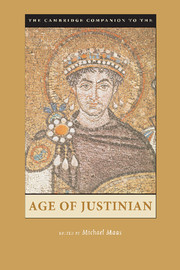Book contents
- Frontmatter
- Part 1 Structures and Ideologies of Empire
- 1 Roman Questions, Byzantine Answers
- 2 Economy and Administration
- 3 Justinian’s Constantinople
- 4 The Classical City in the Sixth Century
- 5 The Empire at War
- 6 Mediterranean Plague in the Age of Justinian
- 7 Law and Legal Practice in the Age of Justinian
- 8 Justinianic Ideology and the Power of the Past
- Part 2 Religion and Philosophy
- Part 3 Literature and the Arts
- Part 4 Peoples and Communities
- Bibliography
- Index
- Plate Section 1
- Plate Section 2
1 - Roman Questions, Byzantine Answers
Contours of the Age of Justinian
from Part 1 - Structures and Ideologies of Empire
Published online by Cambridge University Press: 28 May 2006
- Frontmatter
- Part 1 Structures and Ideologies of Empire
- 1 Roman Questions, Byzantine Answers
- 2 Economy and Administration
- 3 Justinian’s Constantinople
- 4 The Classical City in the Sixth Century
- 5 The Empire at War
- 6 Mediterranean Plague in the Age of Justinian
- 7 Law and Legal Practice in the Age of Justinian
- 8 Justinianic Ideology and the Power of the Past
- Part 2 Religion and Philosophy
- Part 3 Literature and the Arts
- Part 4 Peoples and Communities
- Bibliography
- Index
- Plate Section 1
- Plate Section 2
Summary
Then appeared the emperor Justinian, entrusted by God with this commission, to watch over the whole Roman Empire and, so far as was possible, to remake it.
– Procopius of Caesarea, Buildings 2.6.6, trans. DewingIntroduction
The Age of Justinian stands at a historical milestone, marking a transition from antiquity to the Middle Ages in the Mediterranean world. The period lasted for roughly a century, from the time that the young Justinian came down to Constantinople from his Balkan village around the year 500 to the regime of Phocas that began in 602, when the empire that Justinian had done so much to shape and that had been sustained with great effort by his successors plunged into a period of political instability. Throughout Justinian’s era, recently called “the last of the Roman centuries,” the monarchy begun by Augustus Caesar half a millennium earlier remained a going concern - even though it was now ruled from Constantinople, the “New Rome,” even though most of its inhabitants spoke Greek rather than Latin, even though the old gods who had guided the empire to world rule were now pushed aside by the worshipers of Christ, and despite the uncomfortable fact that much of its territory in western Europe had been lost. Nevertheless, when the Age of Justinian came to a close on the eve of the Islamic conquests, the Roman Empire was still the strongest, best organized, and most resilient political community in Europe or the Near East. It had a sound, even prosperous, economy, and its position in world affairs was relatively solid on all frontiers and commanding in some, so much so that recovery of lost territories again seemed a genuine possibility. Yet somehow, during the century dominated by Justinian (he was sole ruler from 527 to 565, but influential from 518), the Roman Empire subtly changed internally: a new cultural entity that modern historians call Byzantium took shape.
- Type
- Chapter
- Information
- The Cambridge Companion to the Age of Justinian , pp. 3 - 27Publisher: Cambridge University PressPrint publication year: 2005
- 7
- Cited by



